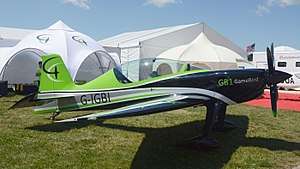Game Composites GB1 GameBird
The Game Composites GB1 GameBird is a British single-engine, two-seat, aerobatic aircraft that was designed by Philipp Steinbach and the first prototype was built by Game Composites.
| GB1 GameBird | |
|---|---|
 | |
| Role | Two-seat aerobatic monoplane |
| National origin | United Kingdom |
| Manufacturer | Game Composites |
| Designer | Philipp Steinbach |
| First flight | 15 July 2015 |
| Number built | at least 28 |
| Unit cost |
$399,000 USD[1] |
Steinbach is a German aircraft designer, but not an aeronautical engineer, so he enlisted the aid of two engineers, Jing Dai and Robert Finney, to complete the design. The design work was done in the United Kingdom under Game Composites Limited of London. The aircraft is built under licence by Game Composites LLC in Bentonville, Arkansas, United States.[1][2][3]
Design and development
The GameBird is a composite structure tandem two-seat, low-wing, cantilever monoplane powered by a 303 horsepower (226 kW) Lycoming AEIO-580-B1A piston engine. The GameBird has a fixed conventional landing gear with a tailwheel.
The prototype GameBird first flew on 15 July 2015.[1]
The GameBird was certified by European Aviation Safety Agency in the CS-23 Aerobatic category on 12 April 2017 and by the US Federal Aviation Administration under FAR 23 on 29 August 2017. As of March 2019 the aircraft does not have a production certificate.[4][3]
As of 30 April 2020, there were 28 GB1 aircraft registered in the US, 22 of which were registered to the manuafacturer in Arkansas.[5]
Specifications
Data from European Aviation Safety Agency, Federal Aviation Administration, Flying.[1][3][4]
General characteristics
- Length: 6.9 m (22 ft 8 in)
- Wingspan: 7.7 m (25 ft 3 in)
- Height: 2.56 m (8 ft 5 in)
- Wing area: 11.3 m2 (122 sq ft)
- Gross weight: 998 kg (2,200 lb)
- Fuel capacity: 311 litres (68 imp gal; 82 US gal)
- Powerplant: 1 × Lycoming AEIO-580-B1A horizontally opposed, six-cylinder aircraft engine, 226 kW (303 hp)
- Propellers: 4-bladed MT-Propeller MTV-14-B-C/C190-130, 1.9 m (6 ft 3 in) diameter clockwise rotation
Performance
- Cruise speed: 370 km/h (230 mph, 200 kn)
- Stall speed: 102 km/h (63 mph, 55 kn)
- Never exceed speed: 433 km/h (269 mph, 234 kn)
- Range: 1,900 km (1,200 mi, 1,000 nmi)
- Service ceiling: 4,572 m (15,000 ft)
- g limits: +/- 10g[1]
See also
Aircraft of comparable role, configuration and era
- Extra 300
- Mudry CAP 230
- MX Aircraft MX2
- Corvus Racer 540
- XtremeAir Sbach 342 (XA 42)
- Zivko Edge 540
- Zlín Z-50
References
- Bergqvist, Per (31 October 2016). "We Fly:GB1 GameBird". Flying. Retrieved 30 July 2019.
- Game Composites. "Contact". www.gamecomposites.com. Retrieved 10 November 2017.
- Federal Aviation Administration (28 March 2019). "Type Certificate Data Sheet No A00073CE" (PDF). faa.gov. Retrieved 30 April 2020.
- ""EAS Type-Certificate Data Sheet A.610" (PDF). European Aviation Safety Agency. 13 April 2017.
- Federal Aviation Administration (30 April 2020). "Make / Model Inquiry Results". Retrieved 30 April 2020.
External links
| Wikimedia Commons has media related to Game Composites GB1 GameBird. |